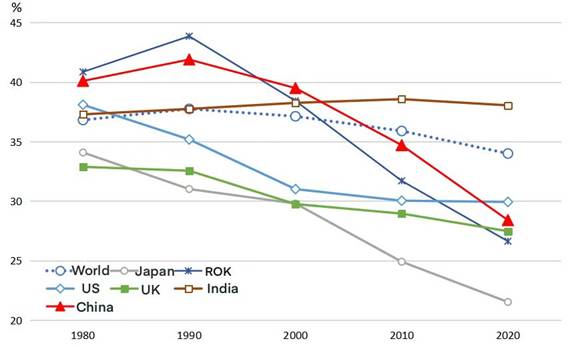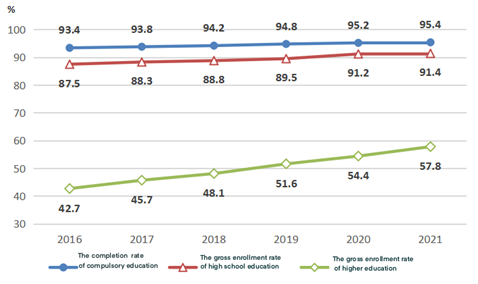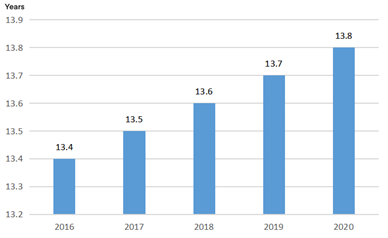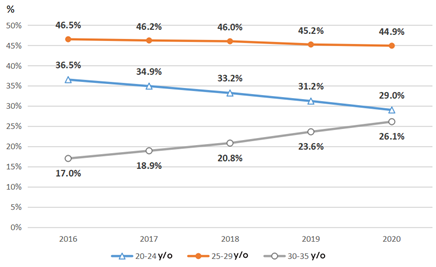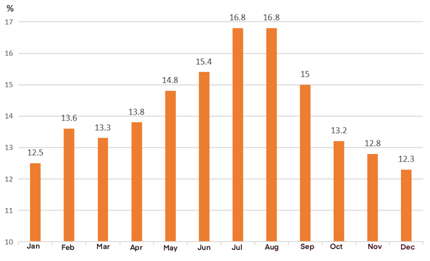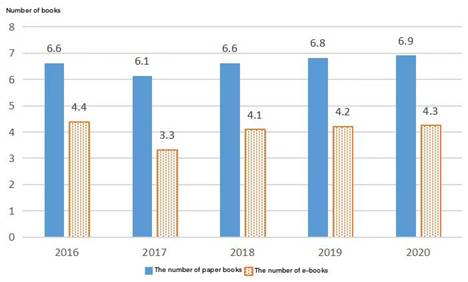Progress Report on China's Youth Development
To show the progress in the implementation of the Medium and Long Term Youth Development Plan (2016-2025) (hereinafter referred to as the Plan) and according to the statistical monitoring outline of the Plan, the Central Committee of the Communist Youth League of China and the National Bureau of Statistics collected data in 2020 by coordinating relevant ministries and government departments and made comprehensive analysis on the changes of youth development in various areas by combining some historical figures.
The result shows that some indicators have reached the standard ahead of schedule along with the continuous and in-depth implementation of the Plan and the display of the effects.
1. Overview of Youth Population
According to the seventh national census in 2020, China's population of youth aged 14-35 was about 400 million, making up 28.4 percent of the total population. Combined with historical data, the youth population has seen a gradual decrease since 2000, when it peaked at 490 million. The figure fell by about 90 million in the two decades to 2020.
Figure 1 Changes of proportions of youth population in the world and some countries
From a worldwide perspective, the proportion of young people in the world population and in some countries[1]has been declining since 1990. Among them, the decline in China, ROK and Japan is faster, and it is slower in the United Kingdom where the proportion is lower. The decline in the United States of America slowed down after 2000. It was after 2010 that India experienced a slow drop.
2. Implementation of the Plan in Various Areas
1) Ideology and Moral Integrity
Education has been carried out on Xi Jinping Thought onSocialism with Chinese Characteristics for a New Era, on ideals and convictions, and on core socialist values. Young people received ideological baptism from the study of the history of the Communist Party of China. They stand firm in their conviction of Marxism and socialism in historical references and in the national reality.
Courses of ideology and politics have been given more emphasis. From 2016 to 2020, ideological and political education in higher education institutions has been part of a credit-bearing course. For these compulsory courses, 16 credits are required for undergraduates, 8 for junior college students, 3 for postgraduate students, and 2 credits for doctoral students. In vocational schools 36 hours of these courses are maintained in each semester. While in high schools, 6 credits were readjusted for compulsory courses on ideology and politics and 0-4 credits were added as selective courses in 2020.
2) Education
Education coverage continues to expand. Since 2016, there has been a continuous rise in the completion rate of compulsory education, the gross enrollment rate of high school education, and the gross enrollment rate of higher education, reaching 95.2 percent, 91.2 percent, and 54.4 percent, respectively, in 2020. Among them, the gross enrollment rate of higher education achieved ahead of time in 2019 the goal of more than 50 percent set in the Plan.
Figure 2 China's education coverage in various stages in 2016-2020
The average years of education for newly increased labor force have grown steadily. Between 2016 and 2020, the number of years rose from 13.4 to 13.8 on average, achieving ahead of time the development goal of "more than 13.5 years" set in the Plan.
Figure 3 The average years of education for China's newly increased labor force from 2016 to 2020
Education equity has been promoted steadily. During the 13th Five-Year-Plan period (2016-2020), the ratio of fiscal expenditure on education in GDP remained above 4 percent, and a financial aid system covering students in all levels of education has been established. In 2020, 85.8 percent of children of migrant workers studied in public schools or benefited from government purchase of private school service.
3) Health
The physical health of young students continues to improve. More students have met the standard of good physical health. The ratio of students aged 13-22 achieving "excellent physical health" level rose to 17.7 percent in 2019 from 14.4 percent in 2014. There has been a continuous improvement in student morphological development indicators. Compared to 2014, there was a significant increase in height, weight, and chest measurement for boys and girls aged 13-22 in 2019.
More attention has been paid to youth mental health. Political, legal, educational and health departments and the CYL organs have been facilitating the improvement of adolescent mental health service system. In 2020, more than 400,000 calls concerning adolescent mental health and legal counseling and more than 3,100 individual cases were dealt with by 12355 Youth Hotline Service run by the CYL Central Committee main station and its six regional centers.
4) Marriage
The number of marriage registration for young people of right age[2]continues to decline. From 2016 to 2020, the number fell from 17.51 million to 12.23 million.
There is a growing trend of late marriage for young people of the right age. The average age of first marriage rose from 26.1 years old in 2016 to 26.8 years old in 2020. Among young people aged 20-35 who have registered to get married, a considerable shift is seen in the proportion of the age group 20-24 and that of the age group 30-35, with the former decreasing from 36.5 percent in 2016 to 29.0 percent in 2020, while the latter increased from 17.0 percent to 26.1 percent.
Figure 4 Proportions of young people of right age in different age groups in marriage registration
5) Employment and Entrepreneurship
The situation of youth employment fluctuates. In 2020, youth employment was greatly affected by the COVID-19 pandemic and the downward pressure of the world economy. A total of 750 million people were employed among which young people aged 16-34 accounted for 31.6 percent, down 2 percentage points from the previous year. The monthly urban unemployment rate for young people aged 16-24 was higher than the same period of the previous year, reaching a peak of 16.8 percent in July and August. A total of 11.86 million new urban jobs were created, 1.66 million fewer than the previous year. In 2020, 8.74 million students graduated from colleges and universities and 4.82 million graduated from secondary vocational schools, showing that young people still make up the majority of new employees.
Figure 5 The monthly urban unemployment rate for young people aged 16-24 in 2020
There are more diversified employment channels for youth. With rapid growth of new business forms such as e-commerce and shared economy driven by fast development of internet, new career choices have been emerging. In 2020, the Ministry of Human Resources and Social Security added 25 new occupations in two batches. Young people have become the main force of employment in new occupations, and can get a job in a broader way. For young people, part-time jobs and job-hopping have become normal.
6) Culture
Young cultural talents enjoy a better growth environment. In 2020, artistic talents and managing personnel have attended online and offline training for more than 9,200 times. Among them, young people made up 37.9 percent, an increase of 11.5 percentage points over the previous year. From 2019 to 2020, China National Arts Fund has sponsored 560 young artists, with total funding of 87.15 million yuan.
The number of books that each young person reads rose in 2020. Young readers on average read 6.9 paper books and 4.3 e-books in 2020. Both figures are higher than the previous year. Paper books, being read by 68.4 percent of young people, remain the main medium for reading and learning by the younger generation.
Figure 6 The number of books that each young person read every year from 2016 to 2020
Internet penetration continues to be strong among young people. In 2020, there were 989 million netizens in China. Young people were the main consumers of cyberculture, such as online literature, music, videos, games, and learning.
7) Social Integration and Participation
Young people are more willing to take part in volunteer service. By the end of 2020, 54.06 million young volunteers have registered on the "China Volunteer" platform, 4.58 million more than the previous year. Since the outbreak of COVID-19 pandemic, more young people have been devoted to volunteer service, with over 1.37 million young volunteers participating in joint prevention and control efforts in various localities.
Youth international exchange has been affected greatly by the pandemic. In 2020, a total of 14.6 million overseas trips were made by young people in Chinese mainland, down about 79.8 percent from the previous year.
8) Safeguarding the Lawful Rights and Interests of Adolescents
Legal protection of minors continues to be improved. In 2020, the Standing Committee of the National People's Congress revised the Law on the Protection of Minors, in which contents of protection by family, school and the society were enriched and new chapters on protection by the cyberspace and the government were added. The Law on Prevention of Juvenile Delinquency was revised, after which a system of differentiated treatment of juvenile deviant behaviors based on seriousness was established. The Amendment (XI) to the Criminal Law was deliberated and passed, so as to crack down on sexual assault against minors. Opinions on a Mandatory Reporting System for Cases of Infringement on Minors were jointly formulated by the Supreme People's Procuratorate and the CYL Central Committee. Thus, a judicial social support system for minors is established.
Rule of law and rights service have been more widely accessible. The lawful rights of minor victims are fully protected in judicial proceedings, and a "one-stop" inquiry and assistance mechanism is in operation for obtaining evidence, psychological guidance, judicial assistance, etc. By the end of 2020, there were more than 1,029 case processing zones for "one-stop" inquiry and assistance, and minors across the country have received more than 120,000 times of legal aid.
More qualified and caring staff have been involved in the protection of minors and their level of care service has been improving. By the end of 2020, nationwide there were a total of 29,000 community service centers for children, 249,000 community service stations, 360,000 parent schools in urban and rural communities, and more than 320,000 children's homes, places for children's activities in urban and rural communities. At county level, there were 55,000 children's supervisors and at village level, there were 667,000 directors of children.
9) Prevention of Juvenile Delinquency
Juvenile delinquency has been effectively curbed. Compared with 2019, the number of juvenile offenders was significantly reduced in 2020 by more than 10 percent. Of the total, the proportions of juvenile offenders and minor offenders declined.
10) Social Security
More young people with disabilities receive education. The number of disabled college students rose from 23,615 in 2016 to 49,565 in 2020. In secondary vocational schools (technical schools not included), the number increased from 18,407 in 2016 to 26,597 in 2020. For youth with disabilities, their employment status has been improving.
Housing problems faced by young people are being tackled. The country is accelerating the establishment of a housing system featuring multiple suppliers and various channels of support that encourages both housing rentals and purchases. The goal is to develop a well-regulated market for long-term house rental by increasing the supply of affordable rental housing. By the end of 2020, 180,000 young medical doctors and 380,000 young teachers became beneficiaries of the public rental housing.
[1]China's data is from national censuses, and the first census after the reform and opening-up was conducted in 1982. The data for other countries is from United Nations World Population Prospects Report 2019.
[2]Young people of right age refer to the youth population aged 35 and under and having reached the legal age of marriage.

